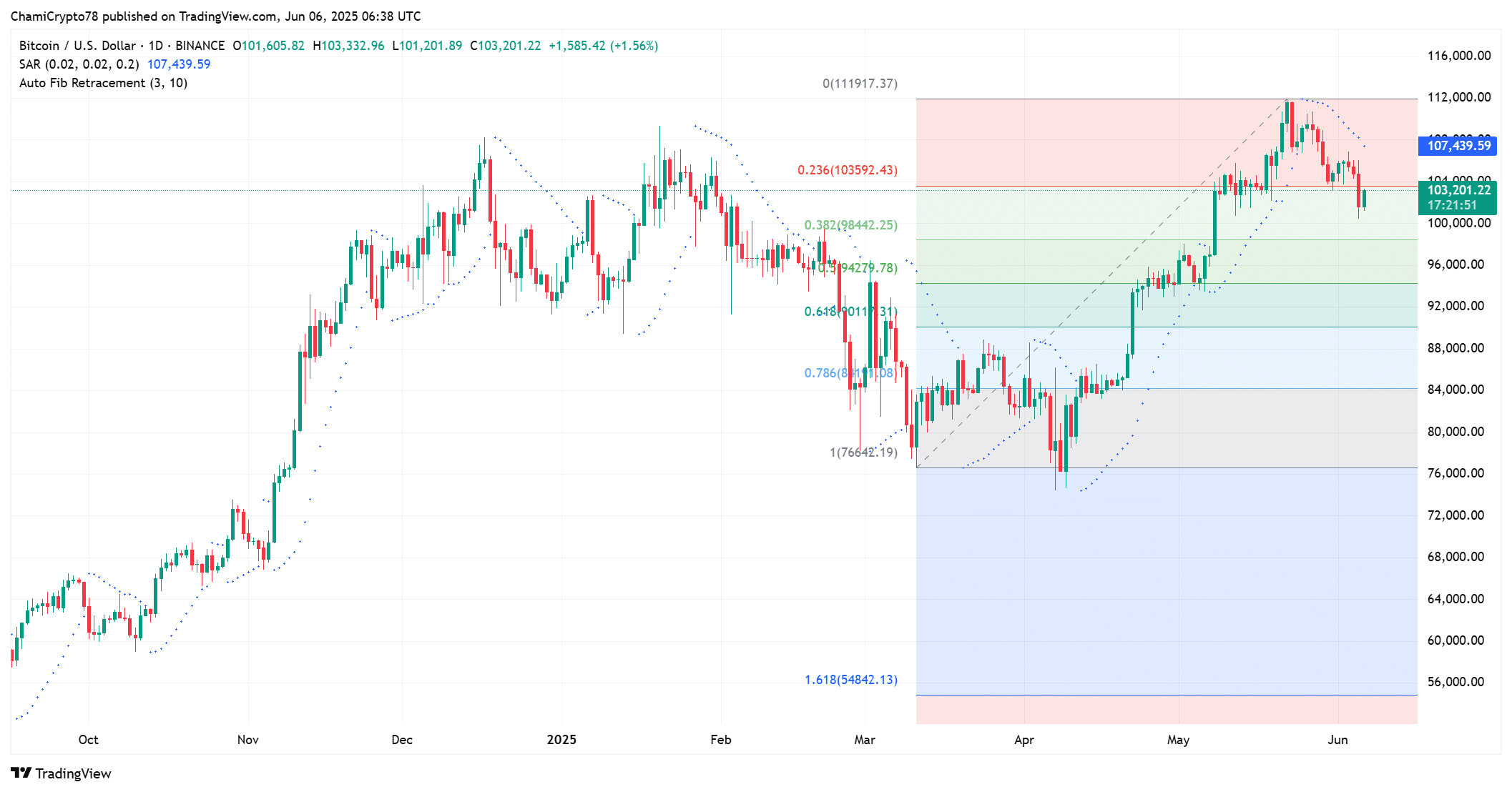-
Bitcoin’s recent pullback from its all-time high signals waning retail interest and diminishing liquidity, challenging its recovery prospects.
-
Despite a decline in exchange reserves suggesting reduced selling pressure, buyer inactivity has kept Bitcoin’s price under pressure near $103K.
-
According to CryptoQuant data, “Supply-Adjusted Coin Days Destroyed rose marginally, indicating long-term holders remain largely inactive amid current volatility.”
Bitcoin faces weakening retail demand and liquidity constraints, struggling to surpass key resistance levels amid muted buyer activity and cautious long-term holders.
Retail Demand Declines as Bitcoin Price Pulls Back from ATH
Bitcoin (BTC) has experienced a notable retreat of approximately 7.21% from its recent all-time high of $111,000, currently trading near $102,994. This pullback coincides with a decline in retail investor enthusiasm, as evidenced by the Total Transfer Volume for transactions under $10,000 dropping from $423 million to $408 million. Additionally, the Retail Investor Demand 30-day change shifted from a positive 5% to a slight negative at -0.11%, underscoring a fading momentum among smaller market participants. This trend highlights the challenges Bitcoin faces in sustaining a robust rebound without renewed engagement from retail investors, who traditionally provide significant liquidity and price support during bullish phases.
Exchange Reserves Drop but Buyer Activity Remains Limited
Interestingly, Bitcoin’s Exchange Reserve — the total amount of BTC held on trading platforms — has decreased by 2.16% to $244.01 billion. This decline typically signals reduced selling pressure, as holders move coins off exchanges into private custody, often interpreted as a bullish indicator. However, the concurrent price decline suggests that buyers have not stepped in to absorb this reduced supply. Instead, the market appears to be in a state of equilibrium where sellers are retreating, but demand remains muted. Without active accumulation and strong spot inflows, the falling exchange reserves alone are insufficient to catalyze a sustained price recovery.

Source: CryptoQuant
Long-Term Holders Maintain Strategic Inactivity Amid Market Volatility
The Supply-Adjusted Coin Days Destroyed (CDD) metric, which measures the activity of long-term Bitcoin holders, increased by only 0.29%. This minimal uptick indicates that these holders are largely refraining from moving or selling their coins, reflecting a strategic decision to remain sidelined rather than reacting to short-term price fluctuations. Their continued inactivity reduces the risk of a panic selloff, which could exacerbate downward pressure. However, it also means that the market lacks the momentum typically generated by long-term holders re-entering the trading cycle, limiting the potential for a strong price recovery in the near term.

Source: CryptoQuant
Technical Indicators Signal Resistance and Continued Bearish Pressure
Bitcoin’s price action reveals significant resistance at two key technical levels: the 0.236 Fibonacci retracement at approximately $103,592 and the Parabolic SAR resistance near $107,439. The inability to sustain a move above these thresholds has resulted in a weakening trend, with bulls struggling to assert control. The current trading price around $102,994 remains below these critical barriers, indicating that sellers retain dominance in the short term. For sentiment to shift positively, Bitcoin must reclaim and hold above the $104,000 level, which would signal renewed buying interest and potentially pave the way for further upside.

Source: TradingView
Will Weak Liquidity Cap Bitcoin’s Rebound Potential?
The convergence of declining retail demand, falling exchange reserves without corresponding buyer activity, and minimal movement from long-term holders suggests Bitcoin may enter a range-bound phase. Without a significant influx of fresh capital or renewed conviction from retail and institutional investors, the cryptocurrency is likely to remain capped below critical resistance levels. Recovery will depend not only on reduced selling pressure but also on increased volume, active accumulation, and the ability to reclaim and sustain price levels above $104,000. Market participants should monitor these dynamics closely to gauge the potential for a sustained bullish turnaround.
Conclusion
Bitcoin’s recent price correction highlights the challenges posed by weakening retail interest and subdued liquidity. While fewer coins on exchanges reduce immediate selling pressure, the lack of buyer engagement and long-term holder activity limits upside momentum. Technical resistance at key Fibonacci and Parabolic SAR levels further constrains recovery prospects. For Bitcoin to regain bullish momentum, it must see renewed retail participation, stronger accumulation, and a decisive break above $104,000. Until then, the market may remain range-bound, underscoring the importance of cautious optimism among investors.





